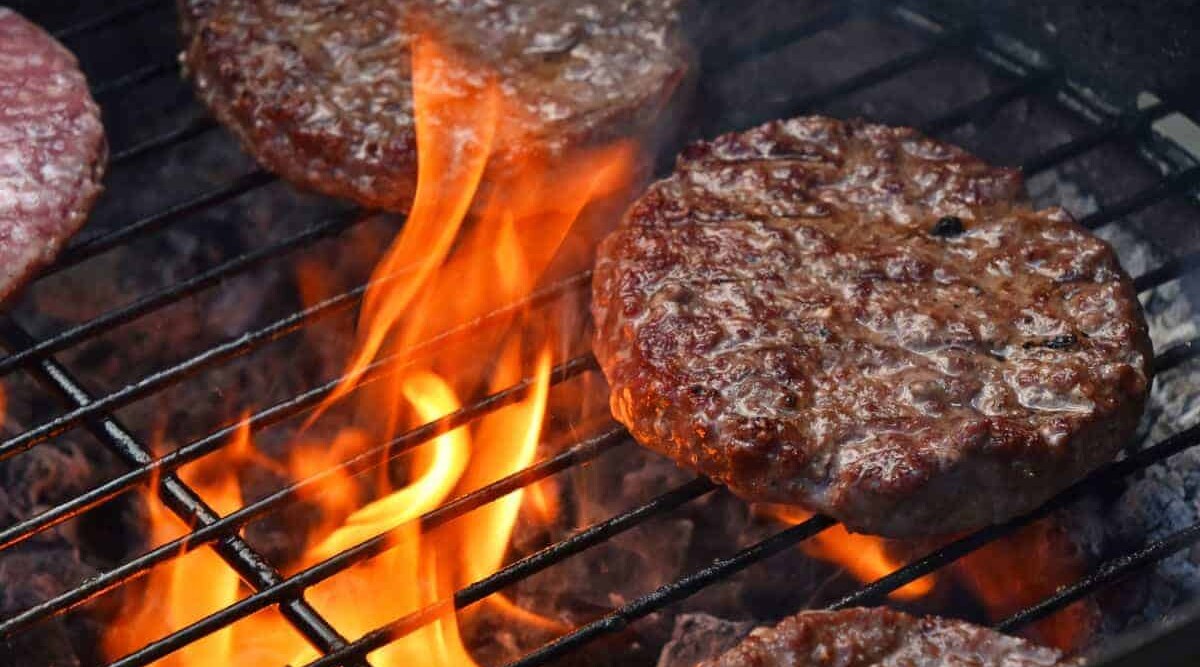
On this site, we’ve already looked at how to make burgers, but we’ve not yet looked into how long it takes to grill a burger to achieve different doneness levels, or the perfect result you’re after.
I’m speaking on a purely personal level here, though I’m sure I’m not alone in this, but there’s little I like better from the barbecue than a delicious burger.
Don’t get me wrong, steaks, chops and ribs are all great! Same goes for grilled veggies — if you can grill it, I’ll eat it. But there’s a special place in my heart for the classic barbecued hamburger.
However, I like mine a little less well done than most. Medium rare to medium in fact. But there’s safety issues at play here when dealing with the temperature of grilled ground meats, due to surface bacteria being minced into the middle.
So do we have to cook our burgers to well done for safety reasons? Or is there a safe way to have them cooked to a lower doneness level?
I mean, here’s the thing; The majority of people like their steak medium rare, maybe even leaning to the rare side. A pink and juicy bit of beef is wonderfully tender and flavorful. However, is it safe to make a hamburger the same way?
In this article, we’re going to discuss how long to grill burgers for a delicious end result, while keeping a keen eye on food safety.
Jump to:
- 1 How Long Should You Grill Burgers? The Bottom Line up Front
- 2 Billions Served, Well Done!
- 3 It’s What’s On the Outside That Counts
- 4 How to Get Sick From Eating Burgers
- 5 Turning Things Inside Out
- 6 Cooking With Mr. (or Mrs.) Clean
- 7 Grinding Your Own Beef
- 8 The Rule of Thumb
- 9 Dry, Tasteless Burgers? Chuck That!
- 10 Done with Doneness
How Long Should You Grill Burgers? The Bottom Line up Front
I’m not going to dive into how to cook burgers in this guide, it’s simply a screaming hot grill and flip once mid-cook. But I will produce an article on this soon.
Anyhow, assuming you know your meat to be safe, here’s how to cook it to various levels of doneness, where I have provided times and temperatures as guides.
All the timings below are for a 1-inch thick burger patty, over a screaming hot grill heat. Whether using a charcoal grill or gas grill, it doesn’t matter. Just get the grill to a very high heat before the burger ever touches it.
Temperature is the best indicator of whether you’ve got your meat to where you want it, but if you don’t have a wireless meat thermometer, you can use your watch instead.
The times are guidelines only, of course, because meat will cook at different rates depending on how thick it is, fat content, starting temp, and a few other variables.
How Long to Grill Burgers for ‘Blue’
Meat cooked to the blue level of doneness is very red in the center and lightly cooked on the outside.
Temperature range: 115-120F
Cooking time: You really just want to sear both sides; 2 minutes on very high heat on each face ought to do it
Grilling a Burger to Rare
Rare beef is soft, cool and red in the center, and only cooked about 1 or 2 mm.
Temperature range: 125-130F
Cooking time: 3 minutes on each side
Achieving a Medium Rare Burger
One of the most popular levels of doneness, medium rare beef is moderately warm and red, and slightly firm.
Temperature range: 130-140F
Cooking time: 3 minutes on one side, 4 minutes on the other
Grilling a Burger to Medium Doneness
Medium is the lowest level of doneness some regulating bodies recommend for cut beef. A medium burger should be slightly pink, warm all the way through, and firm.
Temperature range: 140-150F
Cooking time: 3 minutes on one side, 5 minutes on the other
Hitting the ‘Medium Well’ Doneness Mark
Apparently, this is almost safe to eat. Just a bit of pink will show in the center of the burger, and the meat will be firm.
Temperature range: 150-155F
Cooking time: 3 minutes on one side, 6 minutes on the other
Grilling a ‘Well Done’ Burger
This is the minimum level of doneness for ground beef as recommended by the USDA. Beef should be gray/brown all the way through, hot, and firm.
Temperature range: 160F and up
Cooking time: 3 minutes on one side, 7 minutes on the other
Overcooked Hamburger
I hate to even mention this, but some people really like their meat, “burnt to a crisp,” to quote Steve Buscemi in ‘Pulp Fiction.’
It’s not difficult to cook meat to this level; it’s pretty much black right through, and hard.
Temperature range: over 160F
Cooking time: As long as it takes
Billions Served, Well Done!
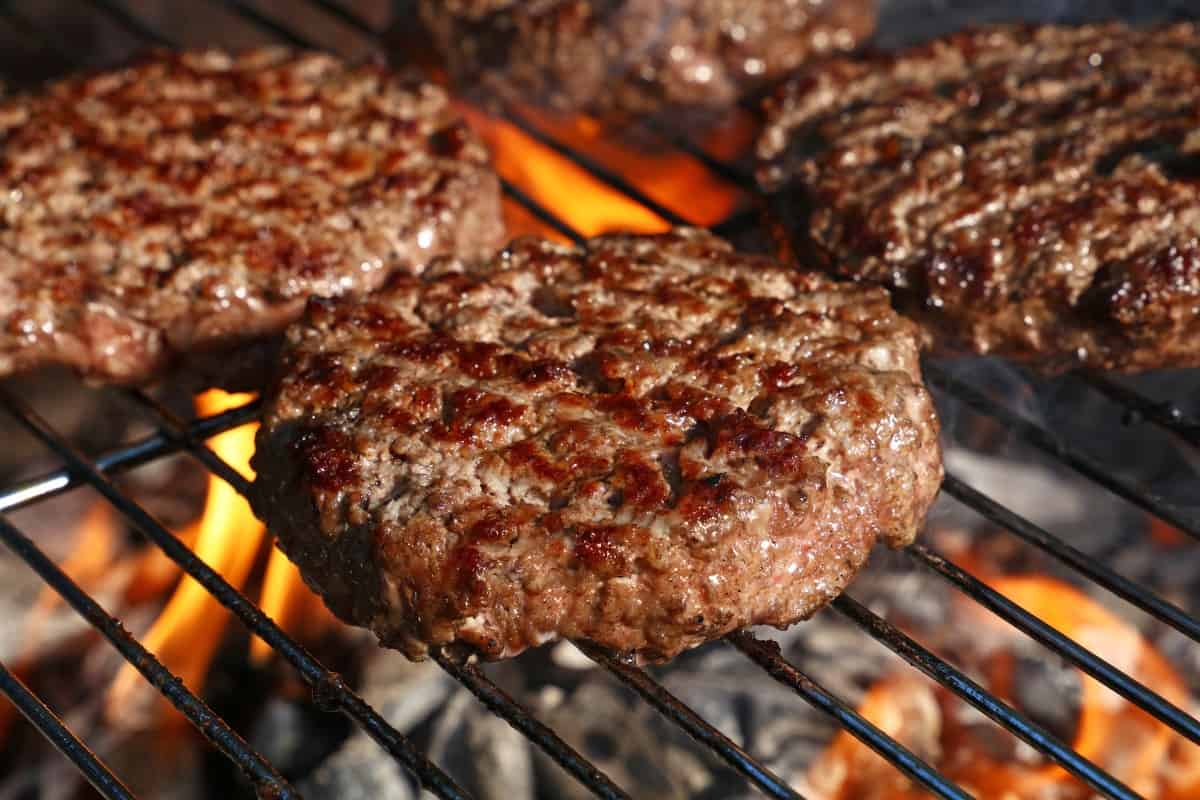
The world loves a hamburger. In the United States alone there are more than 50,000 restaurants where the burger is the focus of the menu. Americans eat around 50 BILLION hamburgers annually. And do you know what most of those burgers have in common? They’re cooked all the way through.
In fact, in many jurisdictions in the U.S., and certainly in Canada, there is legislation banning the serving of “undercooked” hamburgers. Restaurants in Canada have been fined or shut down by food inspectors for this infraction. And the Government of Canada website has a special Hamburger Safety Tips page. Seriously, go look!
Several U.S. states have a ban on selling pink-centered beefburgers, including North Carolina, South Carolina, and Wyoming. Somewhat sensibly, South Carolinians over the age of 18 can choose a medium rare beefburger if they wish. However, I’m trying to imagine how strange it must be to ask for I.D. Before ordering a hamburger!
The thing is, though, some people prefer the taste of a juicy, pink burger.
Of course, you can readily sear a beef burger on the outside, move it off the direct heat, and let it cook for a few minutes until it’s medium rare. The temperature range for medium-rare beef is 130-140F. This is where the government steps in.
According to the United States Department of Agriculture Food and Safety and Inspection Service, the minimum internal temperature for cooking ground meat of any kind is 160F.
However, for just plain ol’ beef they only recommend an internal temperature of 145F. What gives?
It’s What’s On the Outside That Counts
Of course, a lot of us would never dream of cooking a steak until it was 145F on the inside. That falls into the medium well range, which is pushing the upper limits of the doneness scale.
A medium rare steak is at least 10 degrees cooler on the inside, and a rare cut of beef can be as low as 125F, followed by a 3-minute rest. (For the meat, not the chef.)
What’s the reason for the discrepancy? It’s part science and part erring on the side of caution.
The USDA and its counterparts in other countries around the world, is in the business of protecting the public, so they tend to provide conservative guidelines for cooking. They’re generally assuming the meat-handling process was not as pristine as it could be, so they give temperature recommendations that are guaranteed to kill surface bacteria.
Ah, “surface.” That’s the key word here! A raw, unprocessed cut of meat like a steak, or a pork chop likely has its fair share of surface contaminants.
An intact muscle doesn’t have internal bacteria, however. So all you have to do to make it safe to eat is to cook it until the external temperature is high enough to kill the little nasties on the outside.
Once that’s done, the internal temperature barely matters, which is why some serious carnivores opt for their steak to be cooked ‘blue.’ (I’ll stick with warm and juicy, however.)
How to Get Sick From Eating Burgers
So I’ve used the very vague terms, “bacteria,” “contaminants,” and, “nasties,” but I haven’t actually told you what it is you’re trying to kill. There are several unpleasant kinds of bacteria may be present on raw meat, including Salmonella, Listeria, and Staphylococcus.
Escherichia coli is one of the best-known, most common, and least pleasant. E. Coli is found in the intestines of cows and is commonly spread to other cuts during the slaughtering process.
I won’t go into details about what each one can do to your health, but suffice to say, you don’t want any of them. E. Coli, in particular, can wreak havoc on the digestive system, especially in kids.
Turning Things Inside Out
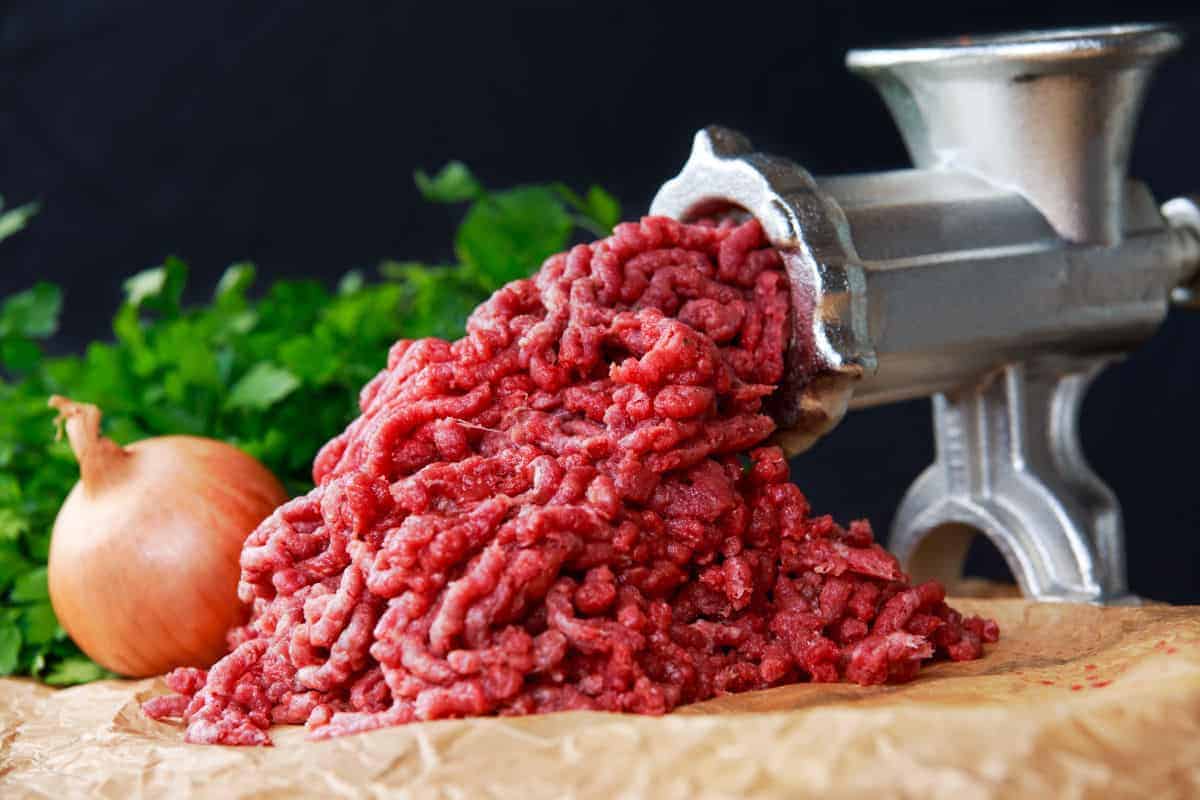
So why does ground meat have its own set of rules? It’s because ground meat is basically turned inside out.
The exterior of the cut gets mixed in with the interior until there’s no telling which was which. This means that any bacteria that was once confined to the outside could now be anywhere in the meat.
For that reason, many people believe it’s necessary to cook ground meat until the internal temperature is high enough to kill any bacteria that may be present anywhere in the meat.
But, what if it wasn’t there in the first place?
Cooking With Mr. (or Mrs.) Clean
By the time you get your ground beef from the grocery store (where most of us get our meat), it has been handled a lot. You really have no idea where it’s been or how it’s been treated.
If it came from a government-inspected processing facility, you could be fairly assured it’s as clean as can reasonably be expected, but you really cannot be sure at all that some surface bacteria hasn’t made its way into the ground meat. So I would recommend always following the USDA advice to take it to 160 F minimum, to be perfectly safe.
Grinding Your Own Beef
Some people, however, prefer to do things their own way.
Grinding your own meat from butchered primal cuts limits the exposure of the meat to possible contaminants. Indeed, some chefs and food experts suggest grinding your own meat in an environment you control will reduce the likelihood of contamination.
If you’re confident your ground meat is free of bacteria, you can cook to lower temperatures and know you and your guests are safe.
It’s worth noting, however, that the USDA recommends against grinding your own meat. They reason is that in their approved facilities they test primal cuts for bacteria, E. Coli in particular, before they grind it.
Unless you’re running a science lab in your home, you have no idea what’s on your meat. And, as I said earlier, grinding meat brings the outside of the meat, where the bacteria live, to the inside.
If you have total confidence in your meat supplier and the cleanliness of your kitchen, this might be your path to a medium-rare patty. However, there are a few methods you can employ to be doubly sure!
Give Your Beef A Bath
If you’re not convinced your own ground beef is safe to cook to medium or less — and I would say you can never be sure — but you really, really want a burger that’s got a touch of the pink inside, there are three methods you can consider.
A leading food scientist says the trick to contaminant-free is to blanch the primal cut before grinding. Evidently, a quick rolling boil, no more than 60 seconds, is enough to kill the bacteria, but not enough to cook more than just the top millimeter or two.
When you grind the cut, the skin of the cooked meat will just mix in, and you’ll never notice it. The meat is now free of bacteria and safe to cook to a lower temperature.
Sear Before Grinding
Another method you can use is to quickly sear all sides of the whole cuts of meat before grinding. Again, just 60 seconds each side is all it would take at a screaming hot temperature to kill all surface bacteria before grinding.
This will mean grinding in some cooked meat into your mix that you wanted entirely pink, but it will be minimal, and you will barely notice, while having earned peace of mind that it is safe to eat.
Pasteurization
Another way to use temperature to decontaminate meat is to pasteurize it.
Pasteurization is the process of using heat to kill contaminants, and it’s most commonly used on milk and juice. You can do the same thing to meat, however.
All you have to do is cook the meat on a low enough temperature to avoid overcooking, and hold that temperature for a (relatively) long time.
For example, to do a medium burger, you bring your grill to 140F and cook at that temperature for 8.6 minutes, according to the Hospitality Institute of Technology and Management.
The Rule of Thumb
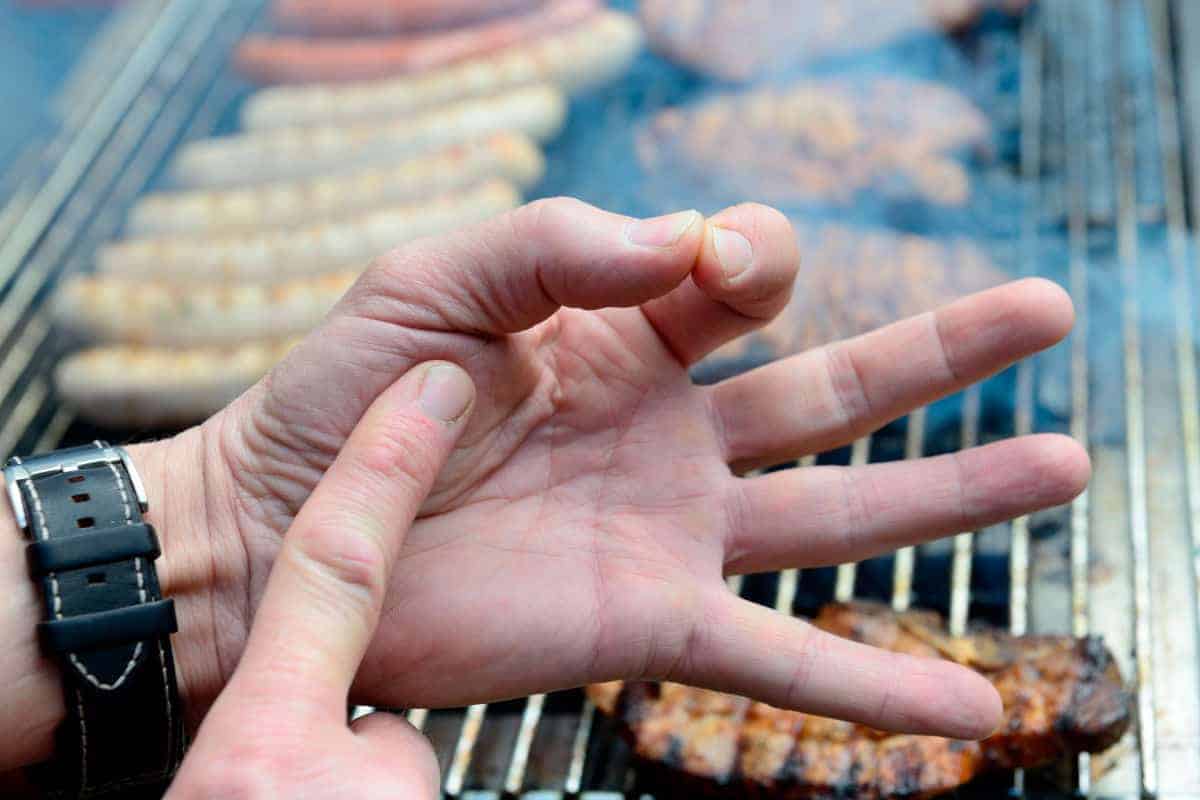
Time and temperature are two indicators of doneness, but if you don’t have a thermometer (and you really should get one, if that’s the case) or a watch, you can usually tell by touching the burger patties to see where the meat is at on the doneness scale.
Many sites, cooks and chefs teach to use this method, but I would advise to steer clear of it and get yourself a good thermometer, as it’s the only real reliable way of checking doneness. (Or you could cut into the burger to see how it looks as a last resort I guess?)
However, I never use this method, I feel it too unreliable, inconsistent and just too inaccurate. Different ground meats can feel very different, so the accuracy of this is just too flawed for me. However, for the sake of completeness I feel I should include the following technique in this guide.
Open up your hand and relax the fist you’ve made because you’re stressed about whether to eat a medium rare burger.
Then, take your index finger from your opposite hand and touch that big wad of flesh at the base of your thumb. Feel how squishy that is? Well, that’s what raw ground beef should feel like when you press it in the center.
Now, gently press your thumb against the index finger on the same hand. How that part of your palm feels now is what a burger cooked rare feels like.
You can keep it going, too: middle finger gives you medium rare, ring finger is medium, and the pinky is well done.
Dry, Tasteless Burgers? Chuck That!
All kinds of non-government food experts and enthusiasts swear up and down that the risk of contracting a food-borne illness from tainted beef is so low, it’s not worth worrying about.
Television food personality and chef Anthony Bourdain thinks the whole thing is ridiculous and once went on an obscenity-laden rant about the issue. I can’t reprint that here, but I can offer this quote from Mr. Bourdain on the subject:
Anyone who refuses to let you eat your burger at a temperature less than medium is on the side of the terrorists.
You have to admire his passion.
Anyway, if you’re still undecided about whether grilling burgers to a lower temperature is safe, but you want a flavorful, juicy burger, here’s the burger hack for you.
You can buy ground beef made from just about any of the primal cuts. And while a burger made from a premium cut of beef sounds enticing, the truth is that pretty much the best burger meat comes from the chuck.
Ground chuck meat has good fat content — not too chewy, and not too lean — which means it will stay moist when cooked, even to a higher well done. Other cuts work well, too, so long as the fat content is 20 to 25 percent.
Less than that, and it’ll dry right up and be no better than a low-grade fast food drive-through beefburger if you take it to the recommended 160 F.
So aim for a good 20% as a ballpark figure, and tweak up or down to your liking.
Done with Doneness
While warnings exist for a reason, governments do sometimes err on the side of caution.
In the end, the question of whether to cook your burgers all the way through or not, is a matter of personal choice. You do what seems right to you, and we won’t judge you, no matter what you decide.
Unless your burger is bad, in which case we will judge you very harshly.
Well, there was a lot more to know about this topic than you thought, wasn’t there? I hope you learned something new and interesting you can share with your friends and family next time you’re gathered ‘round the grill.
And since you’re in the sharing mood, please share this article with your grill groupies and BBQ buds. The more folks that know how to cook a burger, the more likely you are to get served a good one when you’re invited to their cookouts.
If you like what you read, we’d like to know, and if you didn’t like something, we want to know about that, too. Send us your tips, tricks, opinions, corrections — anything you think we should know!
Thanks for reading, and happy grilling!


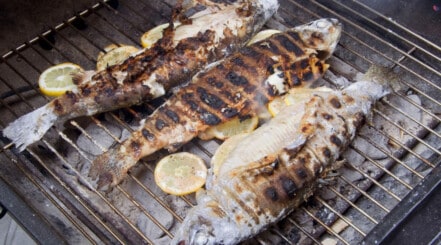
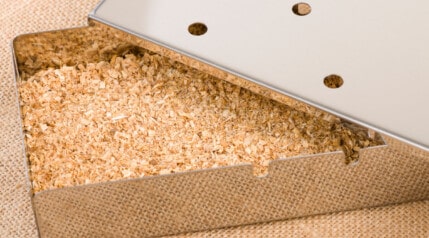

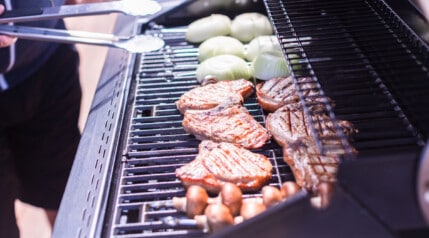
As a police supervisor, I went to a butcher shop and got fresh ground meat, raw egg, and raw onion. I never got sick, and I am 75 plus.
The risks may be low, but they are there, so I’ve a responsibility to make sure people are aware of them.
Hey Mark! Thanks, so much a great article. I have a family that likes burgers “not pink and not dry.” I have tried so many methods with not so great results. VERY few videos or articles seem to cover the “well done” side of the spectrum, but as you’ve pointed out, there are billions served that way. Really GREAT point in my opinion.
All of that being said, the one thing I have wondered with your recommendations for “well done” is it 3 minutes, then 7 minutes with the grill top open or closed? This makes a huge difference in so many ways. Thanks, for any help! Again, loved the article!
Hi Chad. Times are with the lid open. However, they can only ever be approximate as grill temperatures vary from grill model to model, fuel used, ambient air temp, wind, etc.
The best thing to do is always cook to a temperature using an instant-read thermometer to take an internal food temperature. This way, you nail it every time, and variables no longer matter so much!